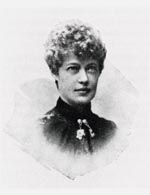Alma Åkermark facts for kids
Quick facts for kids
Alma Åkermark
|
|
|---|---|
 |
|
| Born | 11 June 1853 Domkyrkoförsamlingen in Göteborg |
| Died | 4 June 1933 Oscar Fredriks församling |
| Occupation | Editor |
Alma Mathilda Åkermark (born June 11, 1853 – died June 4, 1933) was an important Swedish woman. She was an editor, writer, and journalist. She also worked hard for women's rights.
Alma helped start a women's newspaper called Framåt, which means 'Forward'. She was the editor for the whole time it was published. She often wrote under the pen name Mark. Alma was a key person in the women's rights movement in Sweden. She was known for her strong opinions on social issues.
Early Life and Education
Alma Åkermark was born in Gothenburg, Sweden. Her father, Anton Wilhelm Åkermark, was a merchant. Her brother, Isak Åkermark, became a painter. Their family knew Sven Adolf Hedlund, a politician and publisher who believed in new ideas.
When Alma was sixteen, her father passed away. Mr. Hedlund helped her financially. This support allowed Alma to study music and drawing in Switzerland. When she returned to Sweden in 1881, she became a teacher. She taught these subjects at a girls' school called Fruntimmersföreningens flickskola.
Through the Hedlund family, Alma became part of a group in Gothenburg that wanted social change. In 1884, the first women's organization in Gothenburg was started. It was called the Gothenburg's Women's Association. Mr. Hedlund's daughter, Mathilda Hedlund, was its leader. Alma was chosen to be on the board the next year.
Starting Framåt
In 1886, Alma Åkermark, Hilma Angered-Strandberg, and Mathilda Hedlund started the women's newspaper Framåt. Alma was the editor, and the women's association helped publish it. Her husband, Albert Breinholm, also worked on the magazine.
Alma Åkermark believed in social reforms. She wanted the newspaper to be a place where people could discuss important topics. She spoke out about fairness between women and men. She believed women should have the same freedoms as men without being judged. Her strong views sometimes caused disagreements with other women's groups who were more moderate.
In 1886, Alma published a novel called Pyrrhussegrar ('Pyrrhic Victories') by Stella Kleve. This book caused a big stir because its ideas were very different from what people expected at the time. Because of this, Framåt lost support from the women's association. However, Mathilda Hedlund, the leader of the association, still supported Alma personally. Sophie Adlersparre, another important figure in the Swedish women's movement, also disagreed with the book's publication. Even so, with help from the Hedlund family, Alma managed to keep publishing the paper herself.
However, Framåt was perhaps too ahead of its time. In 1889, the newspaper had to stop publishing. An organized group stopped advertising in the paper, which meant it ran out of money. Alma also lost her job as a teacher.
Later Years
After Framåt closed, Alma left Gothenburg with her husband. They started a new magazine in Finland called Nya Tag ('New Efforts'). But this magazine only lasted for four months.
In 1891, her husband passed away. Alma became very sad and unwell. In 1892, she returned to Gothenburg and was cared for in a special facility. After she was released in 1896, she moved to the United States. She worked in a factory in Chicago, teaching people how to make patterns.
In 1909, Alma became blind. She then returned to Sweden, where her family took care of her. She passed away in 1933 at the age of 79.
Images for kids
See Also
- Gothenburg's Women's Association
- Framåt
- Sedlighetsdebatten


